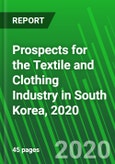The Industry has Embarked on a Strategy of Concentrating on the Development of New Textile Materials with the Aim of Increasing the Added Value of Its Exports
The textile and clothing industry in South Korea played a major role in the country’s initial industrialization but it has subsequently been eclipsed by other industries, notably automotive and electronics. Nevertheless, the textile and clothing industry remains important, and it covers a wide range of vertically integrated activities. Furthermore, it is a substantial exporter - especially in textiles - stemming from the fact that it has an extensive synthetic fibre industry.
Looking to the future, the industry has embarked on a strategy of concentrating on the development of new textile materials with the aim of increasing the added value of its exports. In particular, the focus will be on smart fibres, nanofibres, fibres for healthy lifestyles and sustainability, and high-tech “super fibres”. To help the industry to achieve its export target, South Korea has signed free trade agreements (FTAs) with numerous major countries in the world.
This report looks at the development of the textile and clothing industry in South Korea, its size and structure, and its production and consumption of fibres, textiles and clothing.
The report also features:
- a geographical, political and economic profile;
- a detailed look at South Korea’s imports and exports of textiles and clothing;
- a review of the policies and investment incentives provided by the South Korean government;
- an analysis of foreign direct investment (FDI) in the textile and clothing industry;
- an appraisal of South Korea’s infrastructure and human resources, and an analysis of how these affect the textile and clothing industry;
- and an examination of the industry's strengths, weaknesses, opportunities and threats (SWOT).
Table of Contents
1. SUMMARY
Companies Mentioned
- AB InBev
- Advansa
- BigSky Technologies
- CH-Bioforce
- Cocona
- Designtex
- Devan Chemicals
- DSM Niaga
- HeiQ
- Himatsingka
- Hologenix LLC
- Intertextile Shanghai Home Textiles
- JCPenney
- Lenzing
- Magniflex
- Mattresses Airweave
- Pantone
- Pratibha Syntex
- REI Co-op
- Sanderson
- Sanitized
- Seam Seal International
- Sleep Number
- Tessutica
- The Fairtrade Foundation
- Tident Group
- West Elm








